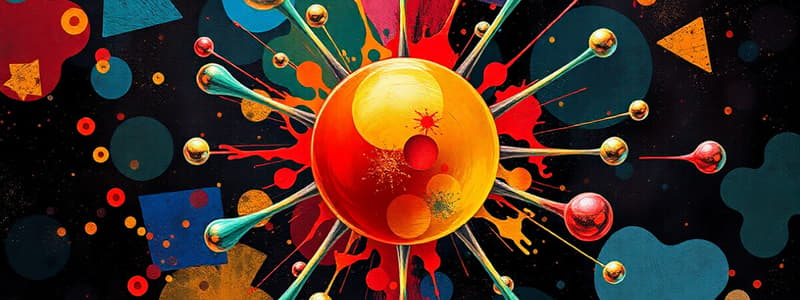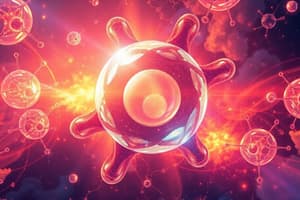Podcast
Questions and Answers
Match the following terms related to matter with their definitions:
Match the following terms related to matter with their definitions:
Matter = Anything that occupies space and has mass Atom = Smallest unit of a chemical element Mixtures = Combination of two or more substances Vacuum = A volume of space without matter
Match the following scientists with their contributions to atomic theory:
Match the following scientists with their contributions to atomic theory:
Democritus = Proposed the idea of indivisible particles called atoms John Dalton = Formulated the Atomic Theory based on empirical laws Niels Bohr = Developed the model of the atom with electron orbits Erwin Schrödinger = Created the wave equation describing electron positions
Match the following types of matter with their descriptions:
Match the following types of matter with their descriptions:
Pure substance = Matter with a consistent composition Element = A pure substance that cannot be broken down Compound = A substance formed from two or more elements chemically bonded Mixture = A physical combination of two or more substances
Match the elements of an atom with their corresponding characteristics:
Match the elements of an atom with their corresponding characteristics:
Match the following laws with their significance in atomic theory:
Match the following laws with their significance in atomic theory:
Match the assumptions of atomic theory with their descriptions:
Match the assumptions of atomic theory with their descriptions:
Match the subatomic particles with their properties:
Match the subatomic particles with their properties:
Match the atomic model with its proponent:
Match the atomic model with its proponent:
Match the type of charge with the corresponding subatomic particle:
Match the type of charge with the corresponding subatomic particle:
Match the terms with their definitions:
Match the terms with their definitions:
Matter is anything that occupies space and has ______.
Matter is anything that occupies space and has ______.
All matter is made up of minute and indestructible particles called ______.
All matter is made up of minute and indestructible particles called ______.
The Greek word 'atomos' means ______.
The Greek word 'atomos' means ______.
Democritus is known as 'the laughing ______' for his contributions to atomic theory.
Democritus is known as 'the laughing ______' for his contributions to atomic theory.
John Dalton used the Law of Conservation of Mass as a basis for his Atomic ______.
John Dalton used the Law of Conservation of Mass as a basis for his Atomic ______.
Each element is composed of extremely small particles called ______.
Each element is composed of extremely small particles called ______.
Atoms of one element cannot be changed into atoms of a different element by ______ reactions.
Atoms of one element cannot be changed into atoms of a different element by ______ reactions.
The nucleus of the atom contains positively charged particles called ______ and neutral particles called ______.
The nucleus of the atom contains positively charged particles called ______ and neutral particles called ______.
The outermost regions of the atom are called electron ______, which contain the negatively charged particles.
The outermost regions of the atom are called electron ______, which contain the negatively charged particles.
The ______ model describes an atom with protons and neutrons in the central nucleus and electrons in orbit around it.
The ______ model describes an atom with protons and neutrons in the central nucleus and electrons in orbit around it.
Flashcards
Matter definition
Matter definition
Anything that occupies space and has mass.
Atom definition
Atom definition
Small, indestructible particles that make up matter.
Atomism
Atomism
The idea that everything is made of atoms.
Atomic Theory
Atomic Theory
Signup and view all the flashcards
Element and Atom
Element and Atom
Signup and view all the flashcards
What are atoms made of?
What are atoms made of?
Signup and view all the flashcards
What's the nucleus?
What's the nucleus?
Signup and view all the flashcards
What are protons?
What are protons?
Signup and view all the flashcards
What are neutrons?
What are neutrons?
Signup and view all the flashcards
What are electrons?
What are electrons?
Signup and view all the flashcards
What is matter?
What is matter?
Signup and view all the flashcards
What did Democritus propose?
What did Democritus propose?
Signup and view all the flashcards
What is 'Atomism'?
What is 'Atomism'?
Signup and view all the flashcards
What is the Atomic Theory?
What is the Atomic Theory?
Signup and view all the flashcards
What defines a chemical element?
What defines a chemical element?
Signup and view all the flashcards
Atoms of the same element
Atoms of the same element
Signup and view all the flashcards
Atom's central core
Atom's central core
Signup and view all the flashcards
Protons' role
Protons' role
Signup and view all the flashcards
Neutrons' function
Neutrons' function
Signup and view all the flashcards
Chemical transformations
Chemical transformations
Signup and view all the flashcards
Study Notes
Matter
- Matter is everything that makes up the universe
- Matter is made of tiny, indestructible particles called atoms (Democritus)
- Matter can be classified as pure substances or mixtures
- A vacuum is an empty space with no matter
Atoms
- Atoms are the basic units of matter (the smallest part of an element).
- Atoms are made of even smaller particles: protons, neutrons, and electrons.
- Protons have a positive charge(+1)
- Neutrons have no charge (0)
- Electrons have a negative charge (-1)
- Protons and neutrons are located in the nucleus (center of the atom) -Electrons orbit the nucleus
Atomic Structure
- The nucleus is small but dense
- Almost all the atom's mass is in the nucleus
- Atoms contain electrons located in electron shells/orbitals outside the nucleus
Subatomic Particles
- Protons (p+): positively charged particles in the nucleus
- Neutrons (n⁰): no charge, in the nucleus
- Electrons (e⁻): negatively charged particles, orbit the nucleus
- Protons and neutrons are called nucleons
- Protons are composed of two up quarks and one down quark.
- Neutrons are composed of one up quark and two down quarks
Atomic Theory (Dalton)
- Elements are made of extremely small particles called atoms
- Atoms of a given element are identical, but different from other elements
- Atoms of different elements combine to form compounds in simple whole number ratios -Atoms are neither created nor destroyed in chemical reactions
Determining the Number of Protons, Electrons, and Neutrons
- Atomic number = number of protons
- Atomic number = number of electrons (in a neutral atom)
- Number of neutrons = mass number - atomic number
- Mass number = protons + neutrons
Atomic Number
- The atomic number (Z) is the number of protons in an atom of an element.
- The atomic number determines the chemical properties of an element
- In the periodic table of elements, the atomic number is located in the upper left of the element and is followed by the symbol which represents the element itself
Molecules
- Molecules are groups of two or more atoms bonded together
- Molecules are the smallest unit of a substance that can take part in a chemical reaction
- Molecules can be simple, complex, or repeating units
- A molecule forms when an atom bonds to other atoms; this may include atoms of the same element as the first atom, or of a different element
Examples of Molecules
- Oxygen (O2)
- Water (H2O)
- Carbon Dioxide (CO2)
- Methane (CH4)
Identifying the Charge of Atoms
- The total charge of an atom is calculated by the number of protons – number of electrons.
- If the number of protons is greater than the number of electrons, the atom has a positive charge
- If the number of electrons is greater than the number of protons, the atom has a negative charge.
Studying That Suits You
Use AI to generate personalized quizzes and flashcards to suit your learning preferences.



